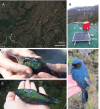Pollination ecology in the tropical Andes: moving towards a cross-scale approach
- PMID: 40664613
- PMCID: PMC12586307
- DOI: 10.1111/brv.70049
Pollination ecology in the tropical Andes: moving towards a cross-scale approach
Abstract
Plant-pollinator interactions structure ecological communities and represent a key component of ecosystem functioning. Pollination networks are expected to be more diverse and specialised in the tropics, but pollination ecology in these regions has been understudied in comparison to other areas. We reviewed research on pollination in the tropical Andes, one of the major biodiversity hotspots on Earth, where the uplift of mountains and past climate have resulted in spatiotemporally distinct species interactions. We found 1010 scientific articles on pollination in the Andes, of which 473 included or were carried out in tropical regions. The number of publications on pollination ecology in the tropical Andes has increased exponentially, with Colombia having the most articles, followed by Ecuador and Peru, and with Bolivia and Venezuela having notably fewer studies. More research has been carried out in humid montane forests and agricultural landscapes, and it has predominantly focused on describing diversity of species and interactions while neglecting analyses on the resilience and adaptability of pollinating systems, even though the Andean region is particularly susceptible to the effects of climate change and continues to undergo land conversion and degradation. Remarkably few studies have incorporated local knowledge, thus ignoring connections to human livelihoods and communities. A phytocentric perspective has been predominant, with fewer studies focusing directly on pollinators and a notable lack of articles with a holistic approach to the study of pollination across taxonomic groups at the community or ecosystem level. We propose that future research adopts a cross-scale approach that considers the complexity of the ecological contexts in which plant-pollinator interactions occur, and incorporates long-term monitoring with broader multilayer networks and molecular tools, experiments focused on ecophysiology and behaviour, animal telemetry, process-modelling approaches and participatory science. A stronger field driven by interdisciplinary collaborations will contribute to knowledge about pollination at a global scale, as well as increase our understanding of the diversity and resilience of pollination interactions in this region, thus improving our capacity to predict and avoid ecosystem collapses.
Keywords: South America; biotic interactions; ecological monitoring; ecosystem functioning; plant–pollinator networks; pollinators.
© 2025 The Author(s). Biological Reviews published by John Wiley & Sons Ltd on behalf of Cambridge Philosophical Society.
Figures










References
-
- Abrahamczyk, S. , Poretschkin, C. & Renner, S. S. (2017). Evolutionary flexibility in five hummingbird/plant mutualistic systems: testing temporal and geographic matching. Journal of Biogeography 44(8), 1847–1855.
-
- Abrahamovich, A. H. & Díaz, N. B. (2002). Bumble bees of the neotropical region (Hymenoptera: Apidae). Biota Colombiana 3(2), 199–214.
-
- * Ackerman, J. D. , Cuevas, A. A. & Hof, D. (2011). Are deception‐pollinated species more variable than those offering a reward? Plant Systematics and Evolution 293(1–4), 91–99.
Publication types
MeSH terms
Grants and funding
LinkOut - more resources
Full Text Sources
Miscellaneous

